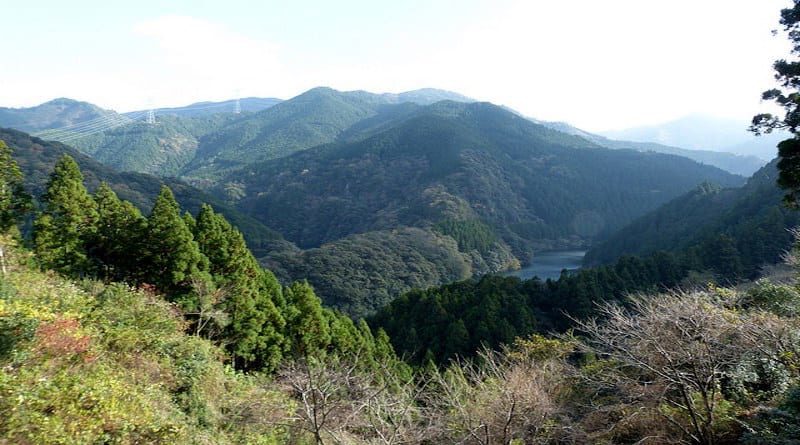Inspiration of a Zero-Waste Town
Dividing you garbage into 60 different categories may seem extreme, but my visit convinced me that it’s something every community should consider.
You may have heard about this Japanese town that separates garbage into 60 categories to hit their Zero-Waste by 2020 target. An ambitious goal indeed, but my visit at the end of last year left me convinced that it’s worth considering in every community.
The town of Kamikatsu-cho [上勝町] in Tokushima Prefecture is a great case study in sustainable community planning that should inspire us all in some way. Accessible from the Hiroshima area in about four hours, the journey takes you through Okayama and over the impressive Seto Ohashi bridges to neighboring Shikoku island. This is a beautiful village set in a valley with wonderful local products, onsen hot-springs, hiking trails and more to attract visitors. My favorite viewpoint greets you upon arrival at the Farmer’s market. Here, the river in the valley below opens up in front of you, it is picture-perfect even on a less-than-perfect wintry day.
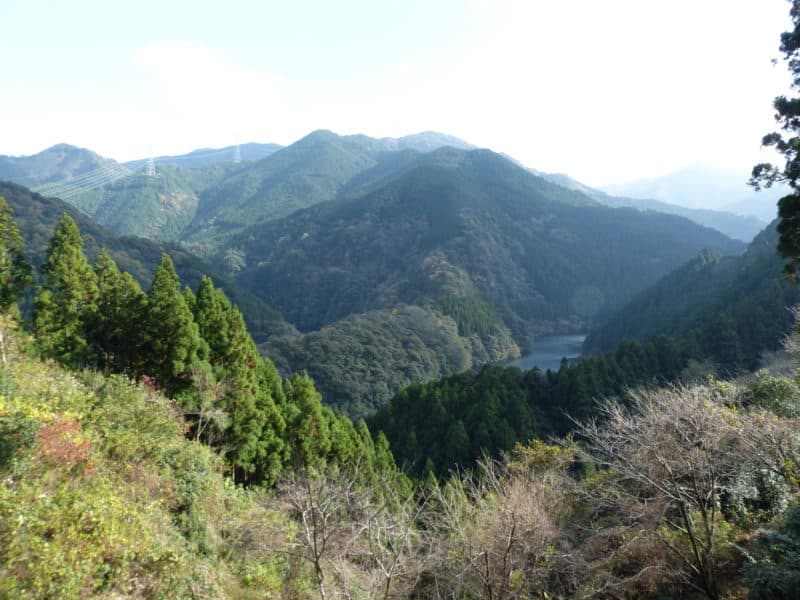
This town probably wouldn’t have gotten on my radar if it wasn’t featured on the JFS site and the Stories youtube channel as the “only place in Japan to aim for a Zero-Waste target”. I was curious as how that is possible. Most garbage in Japan is sorted into three categories- recyclables, burnables and landfill, so I wondered how this town would be different.
Kamikatsu is a town of less than 1700 people and has been designated as one of the “Most Beautiful Villages in Japan.” Striking hillside terraced rice paddies and tea fields add color and culture to the stunning natural views of the valley. The English tourist brochures bring a smile as they promote the town’s “Sparkling rice terraces and Energetic elderly citizens” in marketing slogans.
On our visit, we immediately felt comfortable surrounded by serene nature and beautiful valley views. The town has an established domestic tourism industry and it’s easy to see the attraction for tired urbanites. Historically, domestic tourism to Kamikatsu has focused on its local, high-quality foods, leisure activities such as hot-springs, and active fun in warmer months such as hiking, camping and kayaking. Recently, the town’s zero-waste policies has attracted a new type of visitor drawn to sustainability planning. Thousands of academics, media, government planners and researchers come to the town each year according to Tada-san at the the local town hall. He told me that 2,785 came to the town to do research in 2015 and they expect numbers were higher in 2016.
The target to eliminate waste by 2020 is ambitious and when I visited in the Fall of 2016, they claim to be more than 80% to their goal. In this age of mindfulness, striving for a more fulfilling life, or making business decisions which keep sight of the greater good, zero-waste is becoming a more common concept. The status-quo of accepting wasteful business-as-usual practices is no longer acceptable to many of us who feel we owe it to the next generation to start improving things.
As this is relatively new terrain, having positive examples to draw on can inspire. Last year I was pleased to discover Vancouver’s Granville island which has set up their shopping and dining facility out of derelict factories and partnered with forward thinking companies to create a zero-waste haven. I’ve also been following the heavy investment in infrastructure in San Francisco which aims to be the first city in the US to be zero-waste by 2020. Kamikatsu’s planning and operations are on a much smaller scale, but just as impressive. Their zero-waste initiative was born out of pure necessity as town officials were told they had to cut down on the amount of waste they were burning. 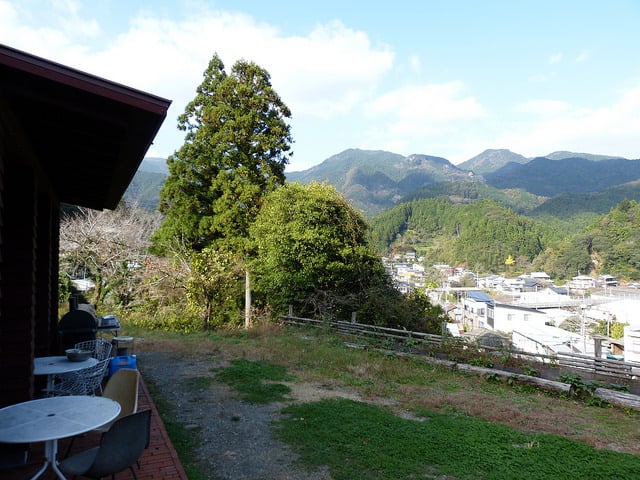 Not unlike other areas of Japan in the early 1990’s, everything was burned- there was no garbage separation or recycling. While other areas added home separation and different garbage pick-up days, it was harder for this town to change as they didn’t have community garbage collection, landfill or even a high-quality incinerator. So, in 1995 the town officials started surveying local residents about waste and subsidized purchases of kitchen waste composting machines. This initial step to cut organics out of the process is significant as 100% composting of kitchen waste has moved them much closer to targets. In 2016, the town estimates that 80% of all garbage is sorted and only 20% of this is being sent to the landfill at a cost. Compared to Japan’s national average where 93% of all waste is incinerated, cutting out incineration completely is a huge step. As Azuma-san told us on our tour, the biggest hurdle is to consider all trash as non-burnable, “it all has to go somewhere!”
Not unlike other areas of Japan in the early 1990’s, everything was burned- there was no garbage separation or recycling. While other areas added home separation and different garbage pick-up days, it was harder for this town to change as they didn’t have community garbage collection, landfill or even a high-quality incinerator. So, in 1995 the town officials started surveying local residents about waste and subsidized purchases of kitchen waste composting machines. This initial step to cut organics out of the process is significant as 100% composting of kitchen waste has moved them much closer to targets. In 2016, the town estimates that 80% of all garbage is sorted and only 20% of this is being sent to the landfill at a cost. Compared to Japan’s national average where 93% of all waste is incinerated, cutting out incineration completely is a huge step. As Azuma-san told us on our tour, the biggest hurdle is to consider all trash as non-burnable, “it all has to go somewhere!”
Since 2002, garbage has been sorted at a central facility into 34 categories. On my recent tour of the facility, I found that there were in fact many sub-categories too. So, although residents bring their waste in a few bags like many of us do in Hiroshima, the trash is then separated with the help of friendly staff into more than 60 overall categories at the sorting station. One might assume that businesses would be reluctant to get behind zero-waste, but it has actually attracted innovative new businesses to the area. Rise & Win brewery and Cafe Polestar are two standouts.
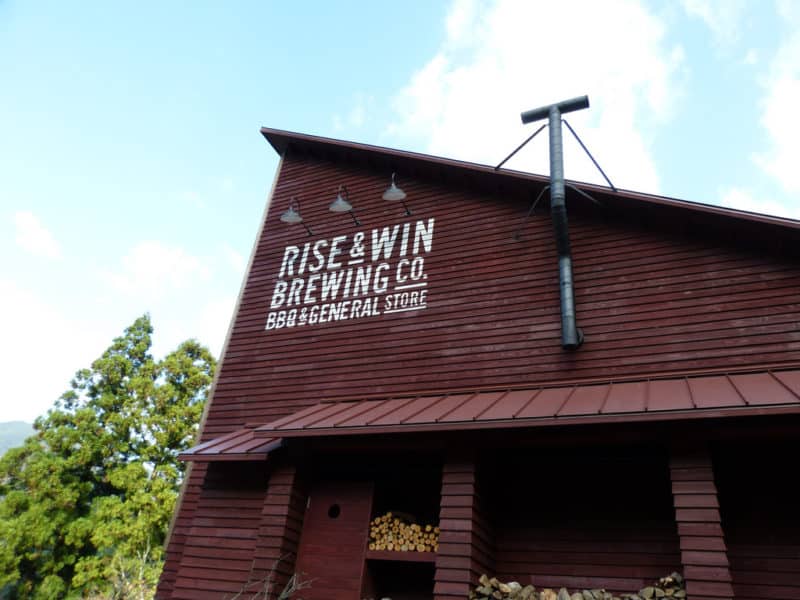 Rise&Win has certainly helped create new appeal to Kamikatsu. As you make the 45 min drive up the valley from Tokushima city, you are first introduced to this amazing Rise & Win microbrewery, BBQ and shop. The friendly staff told me how the owner was drawn to join the zero-waste movement. The building itself is a great example of upcycling, or creating a valuable product from waste. Apparently, Rise&Win’s founder worked with a Tokyo designer to create a wonderfully unique building made out of re-purposed Japanese sliding Shoji doors, windows, local wood and bricks from demolished buildings. The inside is accentuated with shelves made of salvaged bookcases and farming tools, discarded glass bottles and other waste materials newly purposed as a display case for impressive effect. The location of a pristine natural town allows them to use the resource of the delicious local spring water as the source of their brew. There were three varieties available on my visit- the pale, dark and white. My overall favorite is the Leuven-White which is enhanced by subtle flavor from the local discarded YUKO citrus fruit used in the process. Rise & Win are open everyday of the week except Tuesdays and locally sourced BBQ dinners can be booked anytime of year. Microbrew fans in the capitol will be pleased to know there is a new TapRoom bar in Tokyo and there are also online sales available to anywhere in Japan. Following the zero-waste theme, you can fill up with your own containers, bags are made from newspaper and you can see other stylish elements of zero-waste in many aspects of operations.
Rise&Win has certainly helped create new appeal to Kamikatsu. As you make the 45 min drive up the valley from Tokushima city, you are first introduced to this amazing Rise & Win microbrewery, BBQ and shop. The friendly staff told me how the owner was drawn to join the zero-waste movement. The building itself is a great example of upcycling, or creating a valuable product from waste. Apparently, Rise&Win’s founder worked with a Tokyo designer to create a wonderfully unique building made out of re-purposed Japanese sliding Shoji doors, windows, local wood and bricks from demolished buildings. The inside is accentuated with shelves made of salvaged bookcases and farming tools, discarded glass bottles and other waste materials newly purposed as a display case for impressive effect. The location of a pristine natural town allows them to use the resource of the delicious local spring water as the source of their brew. There were three varieties available on my visit- the pale, dark and white. My overall favorite is the Leuven-White which is enhanced by subtle flavor from the local discarded YUKO citrus fruit used in the process. Rise & Win are open everyday of the week except Tuesdays and locally sourced BBQ dinners can be booked anytime of year. Microbrew fans in the capitol will be pleased to know there is a new TapRoom bar in Tokyo and there are also online sales available to anywhere in Japan. Following the zero-waste theme, you can fill up with your own containers, bags are made from newspaper and you can see other stylish elements of zero-waste in many aspects of operations.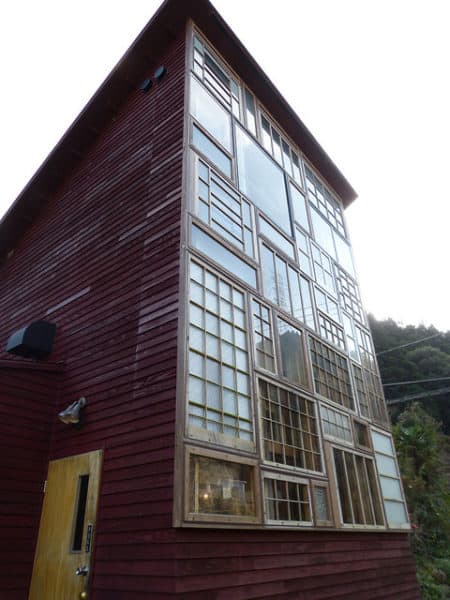
Cafe Polestar is another successful modern, high-quality sustainability-focused business that has moved into Kamikatsu town at the end of 2013. It also takes pride in being part of the Zero-waste movement and sources local ingredients for its beautifully crafted meals as well as offers a few select local products for sale. I was so disappointed that despite staying nearby, we were unable to dine at Polestar, so a more detailed review will have to wait until the next trip. Here’s the Setouchi Finder review of Polestar (5/2016) and the official website as well as their facebook page showing updates of seasonal dishes and restaurant information. Azuma-san of the Zero-waste academy NPO is a co-founder of Cafe Polestar.
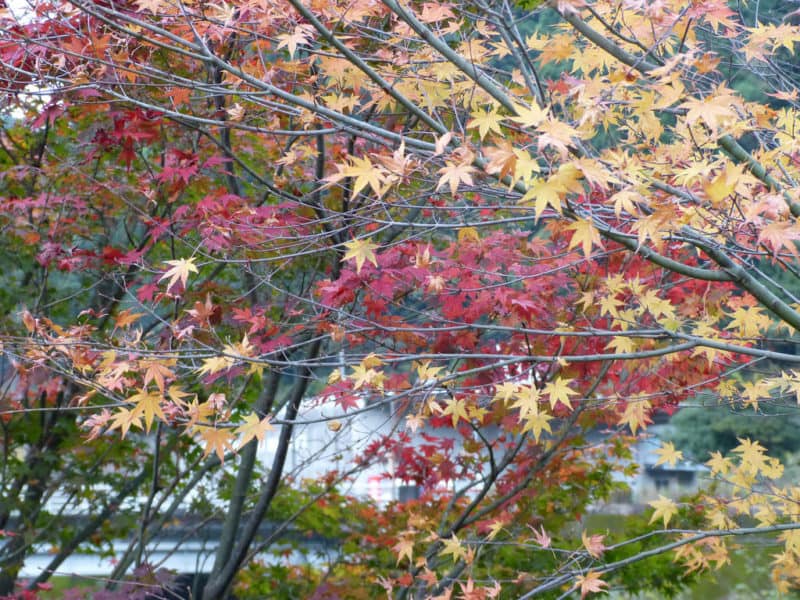 Visitors should also go to the Farmers Market and 2F cafe located next to the viewpoint. This is a great place to store up on locally produced products at great prices. For example, local fruit (bags of Mikan oranges for 100 yen), vegetables, rice and sweets like ice-cream, cookies and mochi rice cakes. There was also a delicious variety of local loose-leaf tea called Kamikatsu Bancha (available at Rakuten / AmazonJP) fermented so it’s full of health benefits. The tea bags we bought can last for many pots of tea and the wonderful fragrant flavor reminds me of a mixture of Jasmine and Green tea.
Visitors should also go to the Farmers Market and 2F cafe located next to the viewpoint. This is a great place to store up on locally produced products at great prices. For example, local fruit (bags of Mikan oranges for 100 yen), vegetables, rice and sweets like ice-cream, cookies and mochi rice cakes. There was also a delicious variety of local loose-leaf tea called Kamikatsu Bancha (available at Rakuten / AmazonJP) fermented so it’s full of health benefits. The tea bags we bought can last for many pots of tea and the wonderful fragrant flavor reminds me of a mixture of Jasmine and Green tea.
Eating on the second floor at the cozy wooden Ikkyu cafe (open from 9am for breakfast and until 3pm) offers beautiful views of the valley on a clear day from large picture windows. The daily set meal is a wonderful healthy and delicious combination of soup, rice, side dishes and a main – all locally sourced. Unfortunately, standard plastic bags are used in the shop as well as waribashi in the cafe, so bring your own bag and chopsticks to show solidarity with the town’s goals. Despite the town’s progress, some business owners still seem resistant as they feel it is poor customer service not to offer the standard conveniences that customers expect.
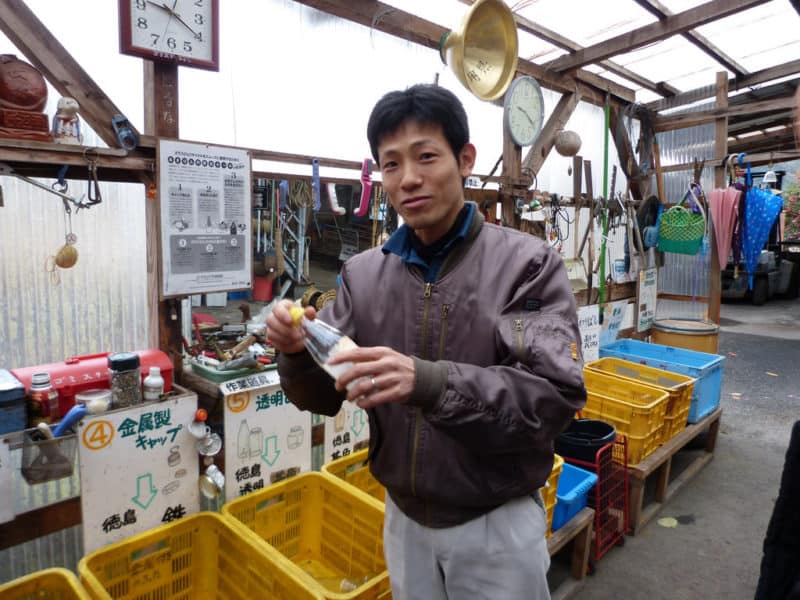 At the nearby Kamikatsu’s garbage sorting center you can book a tour with the knowledgeable Zero-Waste-Academy NPO staff to learn about operations (2,000 yen per person). This is the epicenter of Kamikatsu’s Zero-waste planning and is open every weekday. As there are no garbage trucks in Kamikatsu, all residents and local businesses must bring their waste for sorting, reuse and recycling. It is interesting and inspiring to tour the facility. The staff are friendly and knowledgeable and offer important insights on the facility and its processes. The tour includes an introduction to the facility as well as the Kuru-Kuru re-use shop and the craft (upcycle) KuruKuru shop in the adjacent Zero-Waste academy building. Some of the staff speak English well and there are good materials in English. They sometimes have interns or students who volunteer and help out with Zero-waste operations. Call or email for reservations: zwa (@) quolia.ne.jp Tel: 0885-44-6080 (M-F / 9-5).
At the nearby Kamikatsu’s garbage sorting center you can book a tour with the knowledgeable Zero-Waste-Academy NPO staff to learn about operations (2,000 yen per person). This is the epicenter of Kamikatsu’s Zero-waste planning and is open every weekday. As there are no garbage trucks in Kamikatsu, all residents and local businesses must bring their waste for sorting, reuse and recycling. It is interesting and inspiring to tour the facility. The staff are friendly and knowledgeable and offer important insights on the facility and its processes. The tour includes an introduction to the facility as well as the Kuru-Kuru re-use shop and the craft (upcycle) KuruKuru shop in the adjacent Zero-Waste academy building. Some of the staff speak English well and there are good materials in English. They sometimes have interns or students who volunteer and help out with Zero-waste operations. Call or email for reservations: zwa (@) quolia.ne.jp Tel: 0885-44-6080 (M-F / 9-5).
There are two main hotels in Kamikatsu as well as one Kamikatsu AirBnB which is a beautiful and comfortable renovated old house for around $40 per person per night. There is an Italian restaurant right next door if you book a meal in advance. Tourism has great potential to grow in Kamikatsu which could add a very positive source of income for the town as well as provide a chance to spread the town’s vision further outside of Tokushima, and even Japan.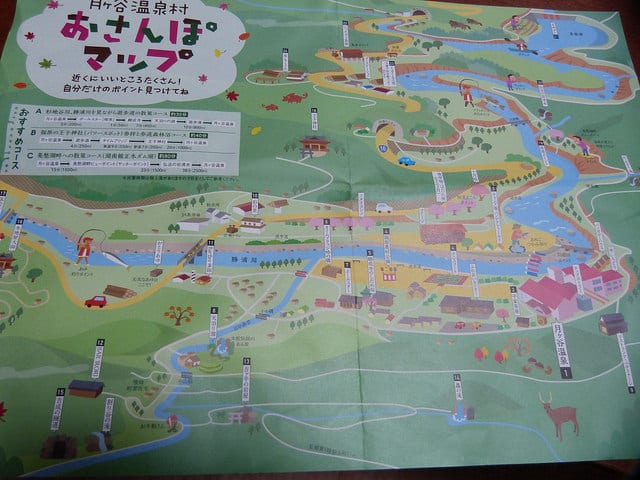
Visitors to the town should have the responsibility to use their own shopping bags and compost their own waste as well as visit the recycling center for sorting at the end of their stay. As a part of the new branding for the town, visitors can be primed for the experience upon booking, so that when they arrive they can reflect a willingness to join the zero-waste target while in the town. I hope to discover stricter guidelines next time I visit, such as a ban of single use waribashi, containers, plastic shopping bags and drink machines. It would still be enjoyable to buy a draft beer from the local Rise & Win brewery or pay 100 yen into an honest-pay-box to enjoy a mug of local Bancha tea. Zero-waste can be a selling point and offer more appeal than the norm of buying a soda in a can or PET bottle. The town is already mostly self-sustainable for food as eateries feature local river fish and a variety of delicious fruits, vegetables and rice.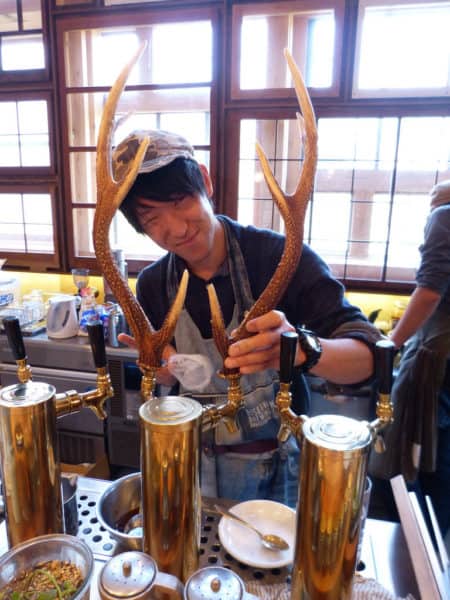
We felt very welcome in Kamikatsu and were fortunate to have the opportunity to talk with people at the city office in charge of the zero-waste policy, as well as the knowledgeable and enthusiastic staff at the Zero-waste academy. This small town did not expect to receive so much attention by governments, researchers and the media from both Japan and abroad when they made their zero-waste target. My research visit was only one of more than 2000 in 2016. The staff we met were happy to share their policies and procedures in hopes that it will inspire similar schemes and programs in other places. There is always hope that their efforts will have a positive knock-on-effect in other communities in Japan and around the world. The video below is a combination of the main points of my visit if you are interested- the messages from the Zero-Waste-Academy co-founders and the intern from Singapore are worth watching.
I think the key to Kamikatsu’s success is not only the official guidelines, but also the public and private partnerships it is establishing. A community discussion followed by official government regulation, mixed with the passion for training and education of the community by the Zero Waste Academy NPO staff, accentuated by the enthusiasm of new businesses like Rise & Win and Polestar all work in harmony. Sakano-san reminds that “Zero-Waste” is a lifestyle, a journey- not a destination.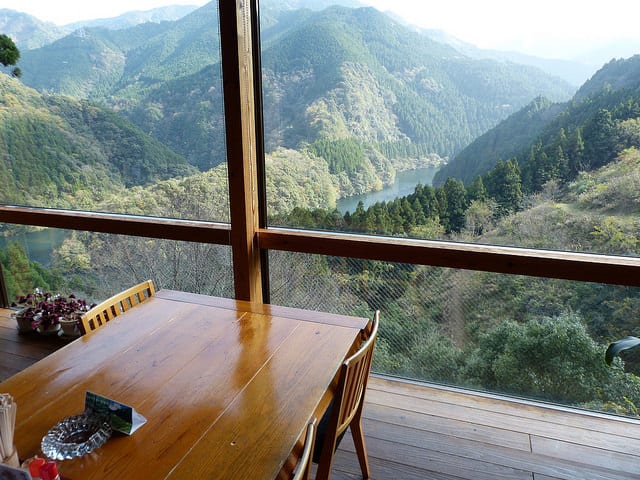
If tourism businesses that also share this passion can get on board and offer carbon-neutral tourist products and lodging in Kamikatsu, it could help propel the town to the next level of financial stability as well as attract new residents and businesses to the town. The most immediate threat to this beautiful town is the decrease in population. This is an issue for for many towns across Japan, but Kamikatsu’s zero-waste targets offer greater appeal to new residents looking to live a more simple, sustainable life in beautiful surroundings. Learning about Kamikatsu has convinced me that this lofty goal offers insight into how any town, city or country can improve not only the natural environment, but also create jobs and businesses while attracting new residents and visitors.
Separating trash into 60+ categories may still seem daunting to us, but we have started composting all of our organic waste and recycle more of our paper and containers at the local supermarket bins to significantly reduce our burnable trash. I wish there were better options for the huge amount of plastic trash we generate on a daily basis. Not bringing it into your home is the key according to zero-waste guru Bea Johnson. Seeking out the regular farmers markets around Hiroshima at the JA in Asa-minami ku and in front of the central NHK building is a start. I have also made a mental note of the community produce boxes in my neighborhood and aim for box-stores that don’t package fresh produce in plastic. We are lucky in Hiroshima to be able to buy in bulk at Costco which reduces packaging, but it doesn’t eliminate it and there is still progress to be made in garbage sorting and reuse opportunities. I dream of one day growing at least some of our vegetables and fruits. I’m grateful to Kamikatsu town and the Zero-waste academy staff for the inspiration.
Related:
- Podcast talk with Akira Sakano, Director Zero Waste Academy NPO
- More details about the Zero-Waste Academy Tour & possible application in other areas
- 11/2016 Akira Sakano: “Zero Waste – A way to enrich your life & society” TEDxAPU
- Akira Sakano’s talk (English) to a New York audience about Kamikatsu’s Zero-Waste targets on Vimeo
- Zero-Waste Academy NPO on facebook – updates & contact for tours
- Kamikatsu town on facebook
- 2/2017 Japan Times writes about the global appeal of Kamikatsu town
- Cafe Polestar – dining & coffee, Kamikatsu town
- Rise & Win Microbrewery, BBQ and shop – Video introduction by Rise & Win staff at their facility


